Vincent Tournier, Senior lecturer in political science at Sciences Po Grenoble and the Pacte laboratory
There's a lot of talk in the news about the logic of rejection being expressed in Europe against ethnic or religious minorities, to the point of requiring mobilization against hate speech.
But what can be said about the degree of openness or closure in European countries? Is tolerance on the rise or in decline? Is it the same in all countries and for all types of minorities?
Measuring tolerance
Documented analyses are rare because they are difficult. The indicators used to measure tolerance are not always well adapted. This is why we propose to shed further light on the subject, based on the European Values Study (EVS).
These surveys, which have been carried out periodically since 1981, have several advantages: they are supervised by academics, they are repeated every nine years (the latest wave was carried out in 2017-2018) and they cover a large number of European countries (around thirty).
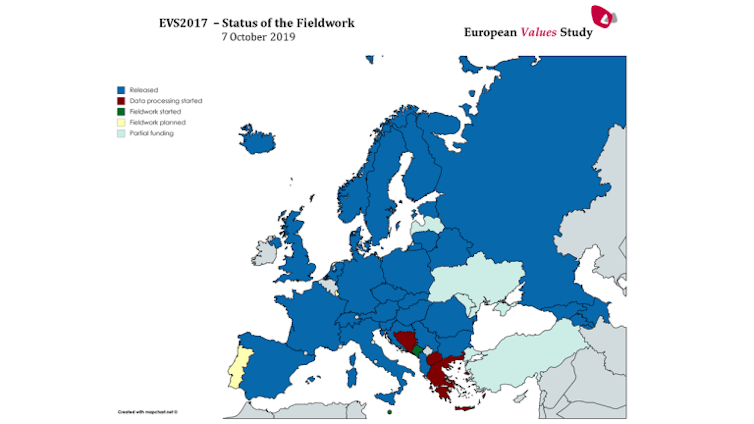
Map of countries surveyed. EVS
Among the questions used in the EVS, one in particular concerns tolerance: it relates to undesirable neighbors. In the French version, this question is formulated as follows:
"On this list are different categories of people. Would you tell me if there are any you wouldn't like to have as neighbours? neighbors?"
As we can see, the originality of this question lies in the fact that it puts individuals in a situation. situation: respondents are not asked abstractly about their level of abstractly about their level of tolerance, but are asked to declare which types of people they would not like to have as neighbors. neighbors. It should be added that this question is easy for everyone to understand even if the notion of neighbor may be considered equivocal.
The list of neighbors proposed in 2017 comprises nine groups (see table 1). It is regrettable that this list has been reduced compared previous surveys. In particular, it does not include political minorities (in this case, right-wing extremists and left-wing left-wing extremists) and other groups such as people with a with criminal records. Nevertheless, this list is broad enough to draw some conclusions.
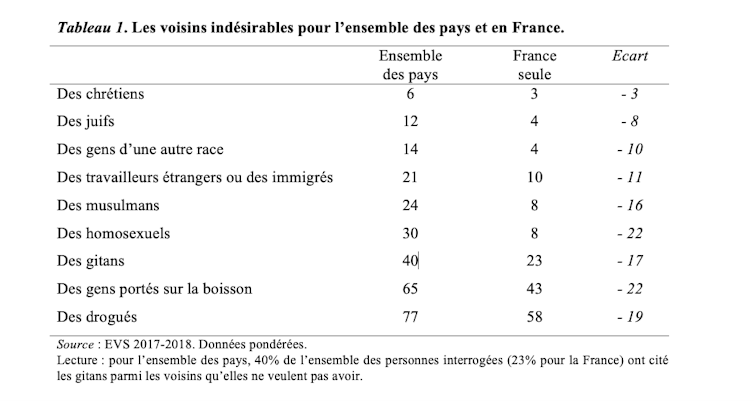
Alcoholics and drug addicts: the unloved neighbors
The first observation is that there are wide variations in Europe depending on the type of neighbor. On average, only two groups are alcoholics (65%) and drug addicts (77%). À the other end of the spectrum, the people who are refused the least are Christians (6%).
Between these two extremes, there is a certain graduation: the most most rejected groups are "gypsies" (40%), homosexuals (30%), Muslims (24%) and immigrants (21%). Far behind come people of "different races" (14%) and Jews (12%). These rejections are not all of the same kind: some are quite cumulative (for example, rejection of Muslim neighbors is highly correlated with rejection of immigrants) and others do not (rejection of Jews is not correlated with rejection drug addicts).
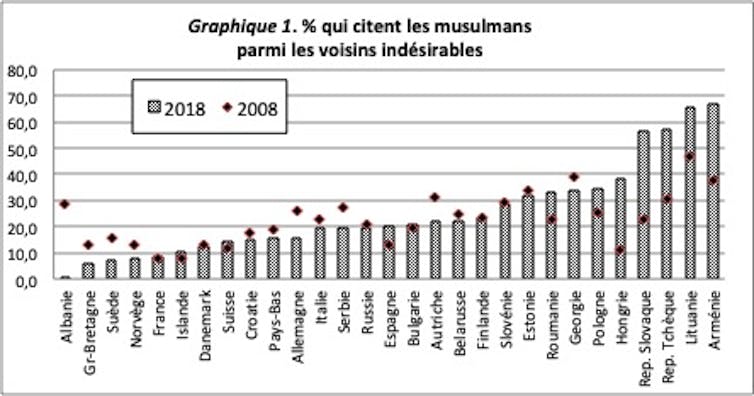
Compared to these European averages, France is a very tolerant country. tolerant country. The hierarchy of rejections is generally the same the same (drug addicts and alcoholics are still the least desired as neighbors), but the scale of rejection is much lower. lower.
In particular, Muslims and people of different races are cited three times less frequently than in the rest of Europe, which invalidates the idea that France is inhospitable inhospitable to these populations.
This result also helps to explain why France was an early a land of immigration, and today is home to Western Europe's largest largest Muslim community in Western Europe, both in absolute and relative terms, with an estimated population of 5.7 million, or 8.8%.
East-West divide
If we now look at the results by country, we can see that significant differences between Western and Eastern Europe. Europe.
The East/West divide is first apparent for ethno-religious minorities minorities (graphs 1 and 2). In Western and Northern Europe, rejection of neighbors of the Muslim faith and of different races is very low, whereas it is high in the East (the same type of divide with the indicator on Jewish neighbors).
This East/West divide has become more pronounced since 2008, as rejection has tended to fall in the West and rise in the East. tendency to decrease in the West and increase in the East, thus increasing polarization. For example, in Hungary, where developments have been spectacular between 2008 and 2018, rejection of Muslim neighbors from 11% to 38%, and the rejection of neighbors of different from 9% to 28%. Once again, we see that France is one of the countries where rejection of Muslims and people of different different races is very low. In 2008, France was even the country where Muslims were least rejected as neighbors.
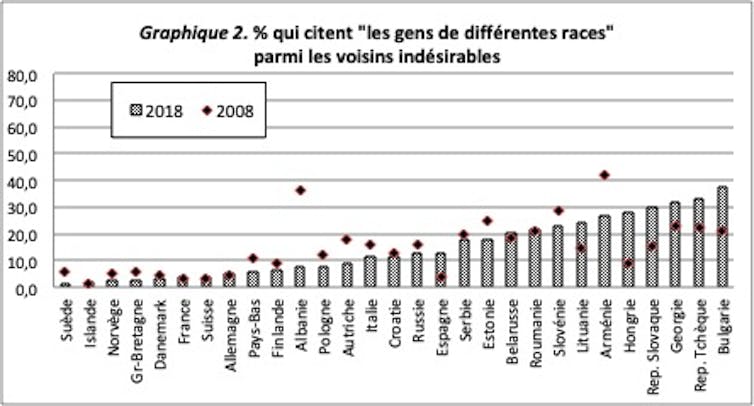
In the case of homosexual neighbors (graph 3), the divide between Western and Eastern Europe is even more marked. In the West, with the exception of Spain, no country is experiencing an increase in rejection, confirming that homosexuality enjoys a strong dynamic of acceptance in the West. In the East, rejection of homosexual neighbors is much more frequent, although there is a wide variation between countries (23% in the Czech Republic, 82% in Armenia). The East/West divide has become more pronounced since 2008, mainly because rejection of homosexual neighbors continues to fall in the West (Netherlands, Germany, Italy, Austria), whereas in the East, despite favorable trends in Poland and Croatia, most countries remain at high levels, or are even moving towards less acceptance.
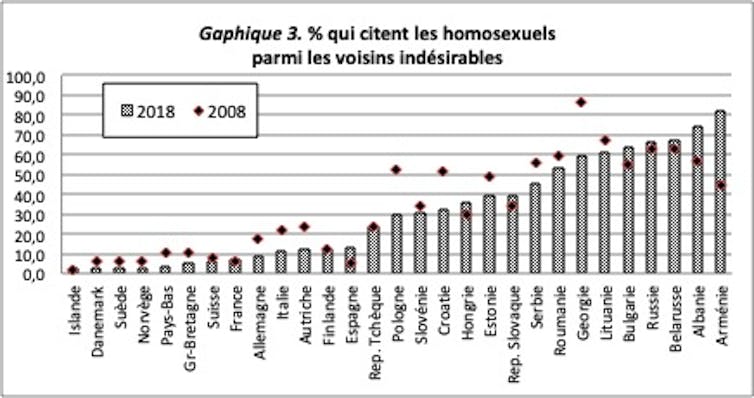
A final case in point concerns neighbors who are drug addicts or alcoholics. This time, even if the differences between East and West are still significant, rejection appears more widespread. rejection appears to be more generalized: not only is it much higher everywhere higher everywhere, but it's also been on the increase in virtually every countries since 2008. This is clearly seen in the case of drugs (graph 4): only in Denmark and Georgia are fewer people do not want drug-addicted neighbors.
In France, where acceptance of drugged neighbors was among the highest in 2008, rejection has risen from 40% to almost 60%. Similar trends are comparable when Europeans are asked about alcoholic neighbors. alcoholic neighbors: at best, rejection of this type of neighbor is stable, but in many countries it is on the rise. Only two countries (Denmark and Finland) have become more tolerant.
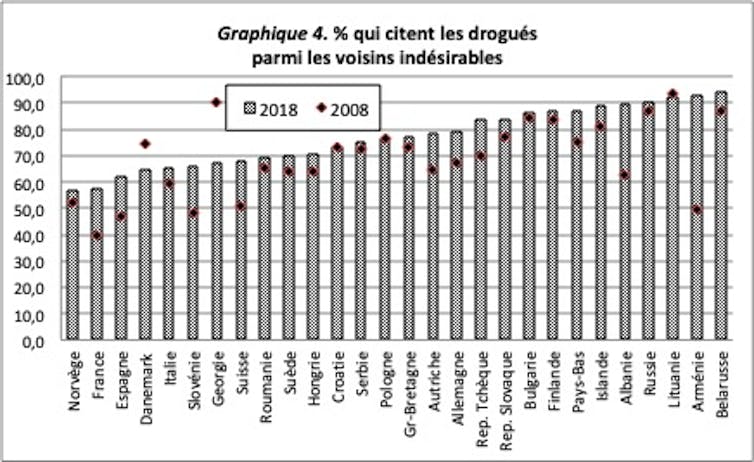
Another look at populist parties
As you can see, ethno-religious and sexual minorities are not are not rejected in the same way everywhere, far from it. All part of Western Europe is, on the contrary, very open-minded when it comes openness when it comes to neighborliness.
This result invites us to take another look at the emergence of populist parties. These parties tend to be analyzed using the same as if populism were a homogeneous phenomenon. homogeneous phenomenon.
However, the EVS data on neighboring countries suggest that these are not comparable, as the electorates do not have the same psychological the same psychological predispositions, the same anthropological anthropological bases. This diversity is no doubt one of the reasons why the difficulties they encounter in unifying at European level.
However, it is possible to question the value of the results. How sincere are the respondents? Do their answers what they really think, or do they reflect the norms and taboos norms and taboos that prevail in each country?
Understanding taboos
This second interpretation must be taken seriously, because in Western Europe, racism and xenophobia have been the subject of a powerful delegitimization since the Second World War and decolonization. and decolonization; at the same time, homosexuality has benefited from increasing visibility and legitimacy.
It is therefore possible that respondents prefer to keep their real opinions to themselves, in line with the logic of the spiral of silence: faced with the fear of being isolated in their social environment, individuals tend to keep their opinions to themselves. We could also mention the impact of of preference falsification which leads individuals to temporarily modify their tastes or tastes or behaviors in certain social contexts. These two discourage dissenting opinions from becoming public.
The role of affinity
While there is some truth in this analysis, it needs to be made more complex. be made more complex. We'll put forward the hypothesis that, when people are asked are asked about the neighbors they want, their answers will depend on two depend on two contradictory principles: a principle of similarity and a similarity and a principle of normativity. The principle of similarity, an expression we borrow from Laurent Cordonier we mean the fact that individuals spontaneously tend, to give preference to people who resemble them in their choice of social in their choice of social relationships.
This preference for resemblance is based on various criteria such as language, ethnicity or culture. In the EVS survey, this in the EVS survey, this principle of similarity is reflected in the fact that Christians are among the least rejected neighbors, while gypsies are more more distrusted. Here we find what Paul Collier calls "cultural distance": the greater the distance, the greater the distrust.
It's a well-known attitude: people always feel closer to those closer to those with whom they feel affinity or proximity, as the affinity or closeness, as confirmed by the "dead mile" phenomenon . Even people who claim to be non-racist have a propensity to help or favor people who are similar to them.
Normativity principle
However, a second parameter must be taken into account: the principle of of normativity. This principle lies in the realm of values. The post-1945 period has been marked by a strong process of individualization. By individualization, we mean the valorization of the individual as an autonomous, responsible being, emancipated and free to make his or her own choices. The EVS surveys have largely confirmed the existence of this process of individualization process, but they also show that it has been in the western part of Europe, for a variety of reasons for a variety of reasons: economic prosperity, religious secularization secularization, peace and democracy, higher levels of education education, and the establishment of the welfare state.
Individualism has become a major normative principle in Western societies, individualism encourages us to judge others not on the basis of their origins origins or collective affiliations (nations, religions, (nations, religions, social classes), but on their personal qualities, even their merits: everyone must be judged for what they do, not for what they are. is. The now systematic injunction not to "amalgamate" in connection with the Islamist attacks makes this clear: only individuals can be held can be held responsible for their actions, not groups.
Contradictory principles
This normative principle is likely to contradict the principle of similarity. principle of similarity. In Western Europe, where individualistic individualistic values, it is hardly conceivable to refuse a neighbour a priori a neighbor because of his or her origin, race or religion. religion.
On the other hand, following the same reasoning, it is perfectly acceptable to reject alcoholics or drug addicts because their situation very different. These two categories are defined by their lifestyle are defined by their lifestyle: they are individuals who have adopted behaviour morally reprehensible, or simply problematic because they are unpredictable and dangerous.
This explanation is confirmed by the fact that, according to the EVS survey, a growing proportion of the population finds it acceptable to use soft drugs, while drug-addicted neighbors neighbours are not accepted. This may seem contradictory, but it may seem contradictory, but it illustrates the individualization of mores. is deemed acceptable in the name of individual freedom, but the adoption of this behavior nonetheless casts suspicion on those who indulge in it. Everyone is free to make their own choices, but to take responsibility for them.
Accepting other people's customs
This approach helps us to understand why many people, despite open to the idea of living together with people from ethno-religious with people from ethno-religious minorities, may have very different have very different practices in real life. It's less a question than a certain type of behavior deemed unsuitable in a society deemed unsuitable in an increasingly individualized society. such as incivility, sexism, intolerance or communitarianism. communitarianism.
This is confirmed by another indicator used in the EVS survey. in the EVS survey: do we want immigrants to maintain their own customs and their own customs and traditions, or adopt those of the host country? country?
This question is presented in the form of a scale from 1 to 10, where 1 means that immigrants should keep their own customs customs and 10 that they should adopt the customs of the host country.
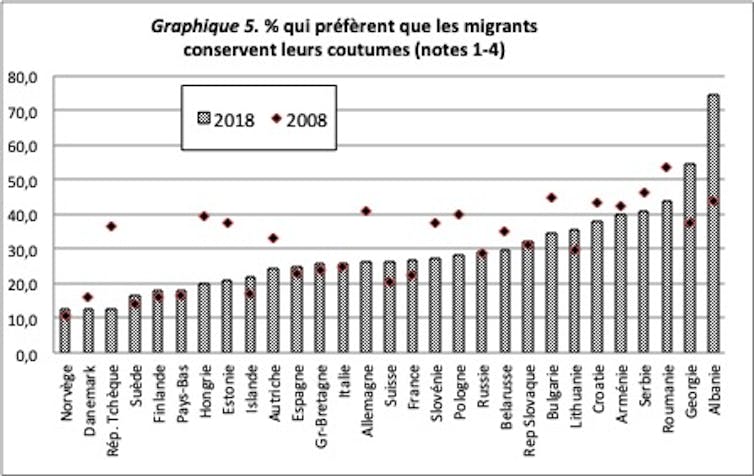
Graph 5 shows the proportion of people who opted for answers 1 to 4, in other words, those who want immigrants to keep their customs, and are therefore more on the multiculturalist side than the assimilationist side.
As we can see, the multiculturalist model is much less supported in the West than in the East, and the dynamics between 2008 and 2018 clearly point in the direction of a decline in the multiculturalist model, including in countries like Austria and Germany, where it enjoyed a degree of support among the populations of these two countries but is now the subject of criticism.
In other words, individualization is a complex process: on the one hand, it encourages greater tolerance in the name of individual freedom, but on the other, it can lead to the rejection of those who don't fit into a certain framework, a certain type of sociability.
This analysis was originally published by The Conversation on February 25, 2020.